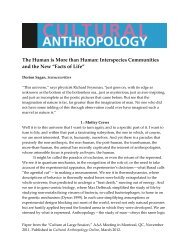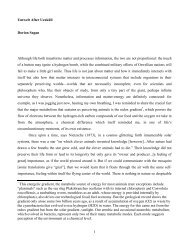PESTICIDES IN COCA-COLA AND PEPSI - Cultural Anthropology
PESTICIDES IN COCA-COLA AND PEPSI - Cultural Anthropology
PESTICIDES IN COCA-COLA AND PEPSI - Cultural Anthropology
Create successful ePaper yourself
Turn your PDF publications into a flip-book with our unique Google optimized e-Paper software.
CULTURAL ANTHROPOLOGY 22:4<br />
678<br />
The stories that the newspapers told about pesticides in Coca-Cola and Pepsi<br />
are largly about the promise of consumerism thwarted. But they also agree that far<br />
from being an incurable condition, it is an aberration, which is, ultimately, remediable<br />
on its own terms. The romance of brands, that some fear might produce a<br />
political paralysis, retains its inventory of contradictory impulses with their incendiary<br />
potential intact. The successful trajectory of the CSE campaign is proof that<br />
even in the present hegemonic moment the multiple disjunctures that constitute the<br />
experience of consumerism can generate a charge potent enough for a way forward.<br />
ABSTRACT<br />
In India, and elsewhere, the effects of globalization, especially increased consumerism,<br />
in expanding the circulation of branded goods, has produced a complex mix of responses<br />
and readings that are often contradictory. In striving to make sense of the apparently<br />
autonomous and often-dizzying pace of economic and cultural change, media and other<br />
discourses utilize narratives and strategies that, although located in symbolic–political<br />
fields, remain contingent in their specific configurations. Coca-Cola and Pepsi as brands<br />
are hybrid embodiments of the larger dissonances constitutive of the present moment in<br />
Indian modernity. On the basis of an analysis primarily of media commentary about<br />
a recent environmental campaign to highlight the presence of pesticides in Coca-Cola<br />
and Pepsi products, this article charts out the recurring discursive motifs that illustrate<br />
the political potential and limitations of the evolving sociopolitical fields, encompassing<br />
such contested categories as the state, multinational corporations, and the consumer,<br />
and their interrelationships in a globalizing India.<br />
Keywords: Coca-Cola, Pepsi, consumerism, brand image, India, liberalization,<br />
environmentalism<br />
NOTES<br />
Acknowledgments. I wish to thank the CSE for their assistance with the research of this article. Partial<br />
funding for this project was provided by a Montclair State University grant, and it is gratefully<br />
acknowledged.<br />
1. The opening heading is derived from the article “Of fuzzy laws and fuzzy drinks” (Girimaji<br />
2003).<br />
2. In an interview the official in charge of the Coca-Cola–Pepsi campaign at CSE described the<br />
publicity generated by the revelations as having exceeded their expectations.<br />
3. Gillespie and Cheesman see middle-class consumerism in aesthetic–cultural terms rather than<br />
as a political force: “If the cosmopolitanism of middle-class India is consumerist rather than<br />
political, generated by media and consumerism rather than by political philosophy or ethics,<br />
what hope is there for the media inspiring alternative political imaginaries?” (2002:129).<br />
4. The Internet has emerged as the hub for sharing of information related to the activities of<br />
the MNCs and for networking of activist groups. One such website is for the India Resource<br />
Center (n.d.), which is a clearinghouse for information about developments pertaining to the<br />
so-called “Coke-India campaign.”






